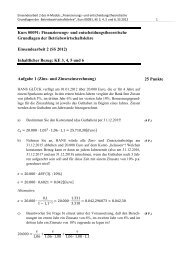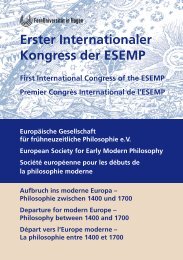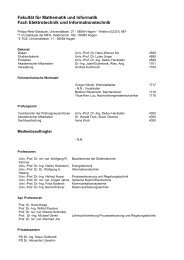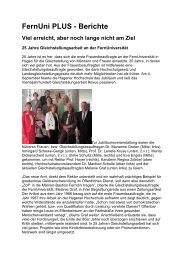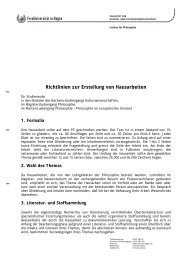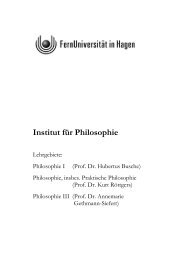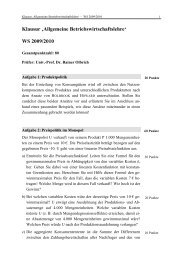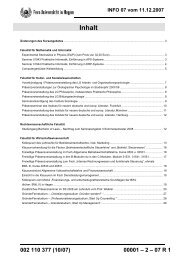An Invitation to Random Schr¨odinger operators - FernUniversität in ...
An Invitation to Random Schr¨odinger operators - FernUniversität in ...
An Invitation to Random Schr¨odinger operators - FernUniversität in ...
Create successful ePaper yourself
Turn your PDF publications into a flip-book with our unique Google optimized e-Paper software.
47<br />
Thus from (5.72) we have<br />
S<strong>in</strong>ce ∫ +M<br />
−M<br />
∫ +M<br />
−M<br />
So, (5.70) implies<br />
∂<br />
∂V j<br />
tr ( ϱ(H Λ (V Λ ) − η) ) g(V j ) dV j ≤ || g|| ∞ .<br />
g(v)dv = 1 we conclude from (5.71) and (5.72) that<br />
( ∂<br />
E tr ( ϱ (H Λ (V Λ ) − η) )) ≤ || g|| ∞ .<br />
∂V j<br />
E ( N Λ (E + ε) − N Λ (E − ε) ) ≤ 4 || g|| ∞ | Λ| ε . (5.75)<br />
□<br />
PROOF (Lemma) : S<strong>in</strong>ce B is a positive symmetric rank one opera<strong>to</strong>r it is of<br />
the form B = c |h〉〈h| with c ≥ 0, i.e. B ϕ = c 〈h, ϕ〉 h for some h.<br />
By the m<strong>in</strong>-max pr<strong>in</strong>ciple (Theorem 3.1)<br />
Ẽ n = sup<br />
ψ 1 ,...,ψ n−1<br />
≤<br />
≤<br />
≤<br />
sup<br />
ψ 1 ,...,ψ n−1<br />
sup<br />
ψ 1 ,...,ψ n−1<br />
sup<br />
ψ 1 ,...,ψ n−1 ,ψ n<br />
<strong>in</strong>f<br />
ϕ⊥ψ 1 ,...,ψ n−1<br />
||ϕ||=1<br />
<strong>in</strong>f<br />
ϕ⊥ψ 1 ,...,ψ n−1<br />
ϕ⊥h ||ϕ||=1<br />
<strong>in</strong>f<br />
ϕ⊥ψ 1 ,...,ψ n−1 ,h<br />
||ϕ||=1<br />
<strong>in</strong>f<br />
ϕ⊥ψ 1 ,...,ψ n−1 ,ψn<br />
||ϕ||=1<br />
〈ϕ, A ϕ〉 + c |〈ϕ, h〉| 2<br />
〈ϕ, A ϕ〉 + c |〈ϕ, h〉| 2<br />
〈ϕ, A ϕ〉<br />
〈ϕ, A ϕ〉<br />
= E n+1 . (5.76)<br />
By the Wegner estimate we know that any given energy E is not an eigenvalue of<br />
(H ω ) ΛL for almost all ω. On the other hand it is clear that for any given ω there<br />
are (as a rule |Λ L |) eigenvalues of (H ω ) ΛL .<br />
This simple fact illustrates that we are not allowed <strong>to</strong> <strong>in</strong>terchange ‘any given E’<br />
and ‘for P−almost all ω’ <strong>in</strong> assertions like the one above. What goes wrong is that<br />
we are try<strong>in</strong>g <strong>to</strong> take an uncountable union of sets of measure zero. This union may<br />
have any measure, if it is measurable at all.<br />
In the follow<strong>in</strong>g we demonstrate a way <strong>to</strong> overcome these difficulties (<strong>in</strong> a sense).<br />
This idea is extremely useful when we want <strong>to</strong> prove pure po<strong>in</strong>t spectrum.<br />
THEOREM 5.27. If Λ 1 , Λ 2 are disjo<strong>in</strong>t f<strong>in</strong>ite subsets of Z d , then<br />
P ( There is an E ∈ R such that dist(E, σ(H Λ1 )) < ε and dist(σ(E, H Λ2 ))) < ε )<br />
≤ 2 C ‖ g ‖ ∞ ε | Λ 1 || Λ 2 | .<br />
□




